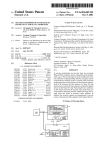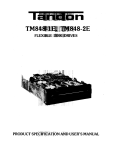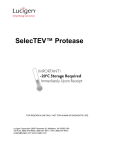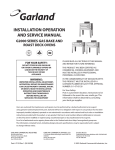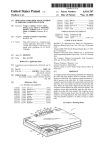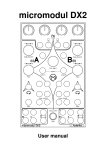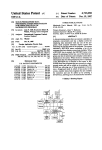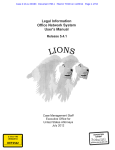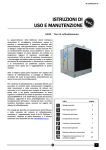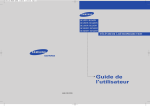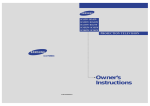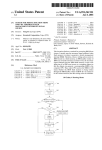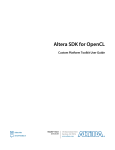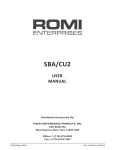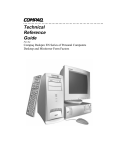Download Method of flash programming or reading a ROM of a computer
Transcript
US006243809B1 (12) United States Patent (10) Patent No.: (45) Date of Patent: Gibbons et al. (54) METHOD OF FLASH PROGRAMMING OR READING A ROM OF A COMPUTER SYSTEM INDEPENDENTLY OF ITS OPERATING SYSTEM (75) Inventors: Patrick L. Gibbons, Magnolia; Paul J. Broyles, III, Cypress, both of TX (US) (73) Assignee: Compaq Computer Corporation, US 6,243,809 B1 Jun. 5, 2001 Intel Corporation, Intel486TM SL Microprocessor SuperSet Programmer’s Reference Manual, System and PoWer Man agement, pp. 6—28 through 6—53. Intel Corporation, PentiumTM Processor User’s Manual, vol. 3: Architecture and Programming Manual, @ Intel Corpo ration 1994, pp. 20—1 through 20—9. * cited by examiner Primary Examiner—Robert Beausoleil Assistant Examiner—Rita Ziemer Houston, TX (US) (74) Attorney, Agent, or Firm—Akin, Gump, Strauss, (*) Notice: Subject to any disclaimer, the term of this patent is extended or adjusted under 35 U.S.C. 154(b) by 0 days. Hauer & Feld, LLP (57) ABSTRACT A computer system provides for ?ashing a non-volatile (21) Appl. No.: 09/070,823 (22) Filed: Apr. 30, 1998 (51) (52) (58) Int. Cl.7 ...................................................... .. G06F 9/00 US. Cl. ............................................... .. 713/1; 713/100 Field of Search ........................................ .. 713/1, 100 (56) U.S. PATENT DOCUMENTS 8/1994 Yuen .................................. .. 395/700 5,375,243 * 12/1994 ParZych eta. 5,684,997 * 5,724,027 11/1997 Kau et al. ...... 3/1998 Shipman et al. 710/200 . . . . . .. 710/260 340/825.31 5,724,544 * 3/1998 5,796,984 * 8/1998 Pearce et al. .. 713/1 5,809,515 * 9/1998 Kaki etal. 5,835,594 * 11/1998 Albrecht et a1. 711/103 380/23 5,835,760 * 10/1998 Nishi ............ .. 711/115 Harmer ........ .. 713/2 5,859,911 * 1/1999 Angelo et a1. ....................... .. 380/25 5,898,843 * 5,956,743 * 4/1999 9/1999 Deceased et a1. ................... .. 360/39 Bruce et al. ..... .. 711/103 5,963,738 * 10/1999 Yamaki et al. 6,009,520 * 12/1999 6,009,524 * 12/1999 Gharda .. ... ... ... image to the non-volatile memory is desired, the image buffer is loaded With a portion of the non-volatile memory image. BIOS interface code is then called to place an SMI event code into a memory and to generate a system man References Cited 5,339,437 memory image to a non-volatile memory and reading data from a non-volatile memory independently of an operating system. An image buffer is allocated in a volatile memory of the computer system. If ?ashing a non-volatile memory 713/100 . . . . . . .. agement interrupt causing the computer system to enter a system management mode. SMI handler code examines the SMI event code and calls SMI service code. Next, the image buffer is located and the portion of the non-volatile memory in the image buffer is ?ashed to the non-volatile memory by the SMI service code. Locating the image buffer may include locating an image header de?ned Within the volatile memory. The image header may include a passWord for providing access to the non-volatile memory. The steps of loading the image buffer, calling BIOS interface code, and ?ashing a portion of the non-volatile memory image to the non-volatile memory may be repeated until the entire non volatile memory image is ?ashed to the non-volatile memory. Alternatively, if reading data from a non-volatile memory independently of an operating system is desired, a system management interrupt is generated to place the 713/1 Olarig et al. ....................... .. 713/200 OTHER PUBLICATIONS Advanced Micro Devices, Inc., “Am291F002T/ Am29F002B, 2 Megabit (262,144><8—Bit) CMOS 5.0 Vol t—only, Sector Architecture, Flash Memory,”@ 1996, pp. computer system in a system management mode, an SMI event code is placed in a memory, the SMI handler code processes the SMI event code and calls SMI service code, the image buffer is located by the SMI service code, and the SMI service code copies data from the non-volatile memory to the image buffer. 29 Claims, 9 Drawing Sheets 1—34. SUlM/IEEHEADER cum/mu Inn/1587mm an HASH w wnunrss an U.S. Patent Jun. 5, 2001 Sheet 2 0f 9 Q»\Eg?m \av\ x35%mm Q56:2::2 52 k 8 mmf \ 8 _ \ B\x85;.*8vain .8\22m8E3 \2 :8 E.85 252a: [mmE\Eéamm\22(2 2.,828k% mmvm\ \Q:5%Cam Eg :S@2a53:m US 6,243,809 B1 U.S. Patent Jun. 5, 2001 Sheet 3 0f 9 US 6,243,809 B1 72 FLA AP RIVER! ATIDN 74 FLAS TE ( 0S CE _INTERFACE) 76 BIOS snvn HAN nu _HANDLER) 78 BIDS SMI SERVICE nuunma (SMI__SERVICE) FIG. 3A IMAGE CMDS HEADER U.S. Patent Jun. 5, 2001 Sheet 4 0f 9 100 ( RDM_FLASH ) [102 ALLDCATE IMAGE BUFFER & IMAGE HEADER INITIALIZE IMAGE HEADER ID ‘ 0/105 SET IMAGE_BUFFER_ADDRESS SET IMAGE__LENGTH TU n SET IMAGE_UFFSET T0 0 ,-110 SET IMAGE HEADER CDMMAND T0 FLASH_CMD II ,-112 FILL IMAGE BUFFER WITH n BYTES 0F ROM IMAGE CALCULATE HASH DF IMAGE BUFFER AND PLACE IN MESSAGE DIGEST FIELDS v SET FLASH IN PROGRESS BIT CALL BIDS INTERFACE TD FLASH IMAGE FIG. 4A /'115 US 6,243,809 B1 U.S. Patent Jun. 5, 2001 Sheet 5 0f 9 US 6,243,809 B1 r117 CLEAR FLASH IN PROGRESS BIT K120 ADD nTO IMAGE_0FFSET 122 'IMAGE_D FFSET =TOTAL ROM IMAGE SIZE U.S. Patent Jun. 5, 2001 Sheet 6 0f 9 US 6,243,809 B1 126 ROM_READ r128 ALLDCATE IMAGE BUFFER & IMAGE HEADER r130 INITIALIZE IMAGE HEADER ID f132 SET IMAGE_LENGTH TD n ,134 SET IMAGE_DFFSET TD 0 ,136 SET IMAGE HEADER COMMAND T0 BACKUP_CMD l CALL BIDS INTERFACE TD READ RDM DATA FIG. 5A r 138 U.S. Patent Jun. 5, 2001 Sheet 7 0f 9 i US 6,243,809 B1 r 142 PROCESS IMAGE BUFFERI r144 ADD n TU |MAGE__0FFSET 146 IMAGE_0FFSET TOTAL DZXTA SIZE ROM_READ COMPLETE FIG. 5B U.S. Patent Jun. 5, 2001 Sheet 8 0f 9 150 ‘ BIUSJNTERFACE ) r152 GENERATE SMI EVENT CODE ‘ f 154 STORE SMI EVENT CODE IN CMUS GENERATE SMI _____________ -- ENTER SMI MUDE " 158 RETURN FIG. 6 160 SM|_HANDLER 162 PROCESS SM! EVENT CODE CALL SMl_v SERVICEf‘I EXIT SMM ( RETURN ) FIG. 7 US 6,243,809 B1 U.S. Patent Jun. 5, 2001 Sheet 9 0f 9 US 6,243,809 B1 168 I SMI_SERVICE ) M f 170 LOCATE AND READ IMAGE HEADER " f‘ VERIFY MESSAGE DIGEST PROVIDE PASSWORD TO ENTER ADMIN MODE 192 COMMAND COMMAND CUBE = CUBE = FLASHTCMD BACKUP_CMD - ? YES / 176 ENABLE FLASH PROGRAMMING ENABLE FLASH PROGRAMMING FLASH IMAGE " TO f FLASH RDM READ DATA v FROMf‘ FLASH RDM ; l v r 182 VERIFY RESULT DISABLE FLASH PROGRAMMING ; r186 EXIT ADMIN MDDE I r 194 190 ( RETURN ) FIG. 8 US 6,243,809 B1 1 2 METHOD OF FLASH PROGRAMMING OR READING A ROM OF A COMPUTER SYSTEM INDEPENDENTLY OF ITS OPERATING SYSTEM SUMMARY OF THE INVENTION Brie?y, the present invention provides a method of ?ash ing a non-volatile memory image to a non-volatile memory of a computer system and reading data from a non-volatile memory independently of an operating system. An image BACKGROUND OF THE INVENTION 1. Field of the Invention The present invention relates to ?ashing and reading a non-volatile memory, and more particularly to ?ashing and reading a read-only memory of a computer system indepen buffer is allocated in a volatile memory of the computer system. If ?ashing a non-volatile memory image to the non-volatile memory is desired, the image buffer is loaded With a portion of the non-volatile memory image. BIOS 10 dently of its operating system. causing the computer system to enter a system management mode. In the system management mode, an SMI handler code 2. Description of the Related Art Access to ?ash ROM devices in a computer system is increasingly being safeguarded by softWare and/or hardWare protection and virtualiZation mechanisms. Such mechanisms, Which range from block locking and Write protection to passWord protection and secure memory devices, may be traversed by devices having the necessary privilege level. In a computer system, an application is 15 examines the SMI event code and calls SMI service code. Next, the SMI service code locates the image buffer, and the portion of the non-volatile memory in the image buffer is ?ashed to the non-volatile memory. Locating the image buffer may include locating an image header de?ned Within the volatile memory. The image header may include a passWord for providing access to the non-volatile memory. typically given the loWest privilege level. An application The steps of loading the image buffer, calling BIOS interface requiring direct access to a ?ash ROM device, such as code, and ?ashing a portion of the non-volatile memory image to the non-volatile memory may be repeated until the softWare for ?ashing a ROM image or for reading a version of a ROM, thus must be able to direct a device having the necessary privilege level to release security protection for interface code is then called to place an SMI event code into a memory and to generate a system management interrupt 25 the ?ash ROM device. Similarly, access to certain areas of a memory space of a computer system, such as high regions entire non-volatile memory image is ?ashed to the non volatile memory. Alternatively, if reading data from a non volatile memory independently of an operating system is SoftWare for ?ashing a ROM image or for reading a version of a ROM has traditionally relied upon a driver to desired, a system management interrupt is generated to place the computer system in a system management mode, the image buffer is located, and data from the non-volatile memory is copied to the image buffer. The present invention further provides a method of pro obtain a privilege level necessary to release any security viding a memory command to a non-volatile memory having protection for a ?ash ROM device and to access certain areas a locked state independently of the operating system. The computer system is placed in a system management mode, of memory Where critical code is often stored, has required a particular privilege level. of a memory space. Drivers (also called device drivers), Which generally serve to link a peripheral device to an 35 and an SMI event code is placed into a memory. The SMI operating system, are commonly used in programming and handler code processes the SMI event code and calls the reading ?ash ROM devices in a computer system. In particular, a driver is typically used to control command and status registers of a ?ash ROM device for erasing, Writing, or reading the device. Various types of information may be SMI service code. Next, an image buffer and image header are located in a volatile memory of the computer system. The image header is then read, and a passWord is provided from the image header to a secure memory device. If the read from a ?ash ROM device, such as status data, ROM version data, device identi?cation data, or a ROM image. Accessing a ?ash ROM device to read or Write data has passWord provided matches the passWord stored in the secure memory device, the secure memory device places the non-volatile memory in an unlocked or unprotected state. A occurred exclusively in an operating system environment. Accessing a ?ash ROM device in an operating system protected command may then be provided from the image 45 header to the non-volatile memory by the SMI service code. environment, hoWever, has required updates to drivers for The non-volatile memory or a volatile memory of the each hardWare and operating system environment in Which computer system stores a driver for performing the method of ?ashing a non-volatile memory image to the non-volatile memory and reading from a non-volatile memory indepen dent of an operating system. The BIOS interface code, SMI handler code, and SMI service code are also stored in the access to a ?ash ROM device is desired. Such updates, for example, may account for de?nitions of neW bus interface standards and neW memory standards. Drivers are also frequently updated to handle neW ROM versions of appli cation softWare, neW device identi?cation codes, or neW non-volatile memory or a volatile memory. In a system memory siZe boundaries. It has been necessary, therefore, to match maintenance of a driver for accessing a ?ash ROM management mode, the SMI service code operates at a high privilege level Which gives the SMI service code access to the non-volatile memory and the full memory space of the computer system. In accordance With the present invention, reading or ?ashing non-volatile memory thus is not depen device With the frequency of changes in the hardWare environment of the ?ash ROM device, the operating system environment, and ROM versions. Most of today’s computer systems provide an operating 55 dent upon the operating system. state knoWn as a protected mode Which supports advanced BRIEF DESCRIPTION OF THE DRAWINGS features. A protected mode has provided hardWare support for multitasking and virtual memory management. At certain times in a protected mode, hoWever, an operating system has been unable to grant a driver the privilege level necessary to release security protection for a ?ash ROM device. An application thus has not been guaranteed access to a ?ash ROM device When a computer system is in a protected mode. A better understanding of the present invention can be obtained When the folloWing detailed description of the preferred embodiment is considered in conjunction With the folloWing draWings, in Which: 65 FIG. 1 is a schematic diagram of a computer system incorporating ?ash ROM security features in accordance With the present invention; US 6,243,809 B1 4 3 management, suspend and resume logic, advanced con?gu ration and poWer interface (ACPI), and system management FIG. 2 is a schematic diagram of a Super I/O chip and a security chip for ?ash ROM security management in accor dance With the present invention; bus (SMBus) control, Which implement the inter-integrated circuit (I2C) control. The ISA bridge 24 supports standard FIG. 3A is a control ?oW diagram of a ROM ?ashing and personal computer input/output (I/O) functions, including a dynamic memory access (DMA) controller, interrupt reading process in accordance With the present invention; FIG. 3B is a data ?oW diagram of the ROM ?ashing and reading process of FIG. 3A; FIGS. 4A and 4B are ?oW charts of an exemplary ROMi FLASH routine in accordance With the present invention; 10 FIGS. 5A and 5B are ?oW charts of an exemplary ROMi netWork interface controller (NIC) 22. The NIC 22 prefer ably supports the THUNDERLANTM poWer management READ routine in accordance With the present invention; speci?cation by Texas Instruments. FIG. 6 is a ?oW chart of an exemplary BIOSi INTERFACE routine in accordance With the present inven tion; 15 FIG. 7 is a ?oW chart of an exemplary SMIiHANDLER The ISA bus 25 couples the ISA bridge 24 to a Super I/O chip 32, Which in the disclosed embodiment is a National Semiconductor Corporation PC87307VUL device. This Super I/O chip 32 provides a variety of input/output routine in accordance With the present invention; and functionality, including a disk drive controller for a disk drive 36, serial ports 38, a mouse port for a mouse 40, a FIG. 8 is a ?oW chart of an exemplary SMIiSERVICE routine called by the SMIiHANDLER routine of FIG. 7 in accordance With the present invention. controllers, a timer, and a real time clock (RTC). The PCI bus 21 couples a variety of devices that generally take advantage of a high speed data path. This includes a small computer system interface (SCSI) controller 20 and a 20 keyboard controller for a keyboard 42, a parallel port 46, and an IrDA port 44. These devices are coupled through con nectors to the Super I/O chip 32. The Super I/O chip 32 DETAILED DESCRIPTION OF THE PREFERRED EMBODIMENT The folloWing patent applications are hereby incorporated by reference as if set forth in their entirety: preferably includes a battery-backed memory 34 such as a 25 The ISA bus 25 is further coupled to a system ROM 30 Common-assigned US. patent application Ser. No. (FIGS. 2 and 3) implemented as ?ash read-only memory. 08/396,343, entitled “SECURITY CONTROL FOR PERSONAL COMPUTER,” ?led on Mar. 3,1995; Commonly-assigned US. patent application Ser. No. 30 09/070,458, entitled “METHOD AND APPARATUS The system ROM 30 includes basic input/output services (BIOS) code for execution by the processor 12. The ISA bus 25 couples the ISA bridge 24 to a security, poWer, ACPI, and miscellaneous application speci?c integrated circuit (ASIC) FOR PROVIDING REMOTE ACCESS TO SECU RITY FEATURES ON A COMPUTER NETWORK,” 48, Which provides a variety of miscellaneous functions for the computer system S. The ASIC 48 includes security ?led on Apr. 30, 1998, Commonly assigned US. patent application Ser. No. CMOS memory for storage of passWords supported by the computer system S. features, system poWer control, light emitting diode (LED) 09/070,866, entitled “METHOD AND APPARATUS control, a PCI arbiter, remote Wakeup logic, system fan control, hood lock control, ACPI registers and support, FOR FLASHING ESCD AND VARIABLES INTO A system temperature control, and various glue logic. 35 ROM,” ?led on Apr. 30, 1998; and Referring to FIG. 2, the contents of the Super I/O chip 32 Commonly assigned US. patent application Ser. No. 09/,070,942, entitled “METHOD AND APPARATUS and security ASIC 48 for use With the present invention are 40 FOR REMOTE ROM FLASHING AND SECURITY MANAGEMENT FOR A COMPUTER SYSTEM,” ?led on Apr. 30, 1998. Turning to FIG. 1, illustrated as a typical computer system S implemented according to the present invention. While this system is illustrative of one embodiment, the techniques according to the present invention can be implemented in a Wide variety of systems. The computer system S in the illustrated embodiment is a PCI bus/ISA bus based machine, 45 having a peripheral component interconnect (PCI) bus 21 and an industry standard architecture (ISA) bus 25. The PCI bus 21 is controlled by PCI controller circuitry Within a host bridge 18. The host bridge 18 couples the PCI bus 21 to a host bus 15. The disclosed host bridge 18 includes interface circuitry for a system random access memory (RAM) 16. The system RAM 16 preferably supports extended data out 55 (EDO), dynamic random access memory (DRAM) and synchronous DRAM (SRAM). An ISA bridge 24 bridge is 60 microprocessor core 12 and a level 2 (L2) cache 14. The ISA bridge 24 includes an integrated IDE controller for controlling up to four enhanced IDE drives 28 and a universal serial bus (USB) controller for controlling USB ports 26. The ISA bridge 24 also includes enhanced poWer management. The enhanced poWer management Within the ISA bridge 24 includes full clock control, device passWord. The ?ash ROM passWord controls access to the system ROM 30. CMOS memory 34 may also include a CMOS location 51 for storing a user poWer-on passWord and a CMOS location 53 for storing an administrator passWord. In the disclosed embodiment, the ?ash ROM passWord is the administrator passWord. Access to the CMOS locations 50, 51 and 53 is controlled by an AEN signal 68 externally designated as SIOAEN 64, and an IOWC# signal 70 exter nally designated as SIOWCL 66. It should be understood that components Within the Super I/O chip 32 Which are not related to the present invention have been omitted. The security ASIC 48 includes a “black box” 52. The black box 52, Which is a secure memory device for locking and unlocking resources Within the computer system S such as the system ROM 30, is coupled to a black box status/data register 60 and a black box command register 58. In the disclosed embodiment, the black box 52 provides three slots: Slot 0, Slot 1, and Slot 2, respectively. Slot 0 indicated betWeen the PCI bus 21 and the ISA bridge 25. The host bus 15 is coupled to a processor module 10 Which includes a shoWn. The CMOS memory 34 Within the Super I/O chip 32 includes a CMOS location 50 for storing a ?ash ROM at 49 is used to store the ?ash ROM passWord for locking and unlocking the system ROM 30. When the system ROM 30 is in a locked state, Write cycles to the system ROM 30 are blocked. When the system ROM 30 is in an unlocked 65 state, Write cycles and read cycles to the system ROM 30 are permitted. Slot 1 indicated at 54 may be used for storing the user poWer-on passWord, and Slot 2 indicated at 56 may be used for storing the administrator passWord. US 6,243,809 B1 5 6 In the disclosed embodiment, the blackbox command register 58 is a 7-bit I/O mapped register. Bits 7—5 are index bits allowing for selection of a particular slot of the black box 52. A command provided to the blackbox command register 58 is directed to the particular slot selected. Bit 4 is 66. If the security logic 62 asserts the SIOAEN signal 64, blockage of Write operations to the passWord CMOS loca preferably reserved and therefore should return a “0” When read. Bits 3—0 are used for storing a blackbox command provided to the blackbox command register 58. The com mand sequence ’0000’ represents a Read Status blackbox command. The Read Status blackbox command causes the tions 50, 51 and 53 occurs. If the security logic 62 asserts the SIOWCL signal 66, both Writes and reads are blocked to the passWord CMOS locations 50, 51 and 53. If both the SIOAEN signal and the SIOWCL signal 66 are deasserted, read and Write cycles to the passWord CMOS locations 50, 51 and 53 may be decoded. BIOS code in connection With the security chip 48 and the Super I/O chip 32 thus controls 10 the status of the black box 52. The command sequence ’0001’ represents the Store PassWord blackbox command. FolloWing the Store PassWord blackbox command, the next 8 bytes Written to the blackbox status/data register 60 are access to the ?ash ROM passWord used for locking and unlocking the system ROM 30. next byte read from the blackbox status/data register 60 to be Referring to FIG. 3A, a control ?oW diagram of a process 15 for ?ashing and reading the system ROM 30 in accordance With the present invention is shoWn. Referring to FIG. 3B, a data ?oW diagram of the process for ?ashing and reading the system ROM 30 is shoWn. The solid-line arroWs stored as the passWord. The command sequence ’0010’ represents the Protect Resources blackbox command. The Protect Resources blackbox command locks a selected blackbox slot. The command sequences ’0100’ represents the Access Resources blackbox command. The Access Resources blackbox command compares the next 8 bytes Written to the status/data blackbox register 60 With the components in FIG. 3A represent softWare for the disclosed embodiment, and the components in FIG. 3B represent hardWare for the disclosed embodiment. In accordance With the present invention, at boot up of the computer system S, passWord bytes previously stored in the selected blackbox the system ROM 30 includes in its contents a ?ash driver or slot using the Store PassWord blackbox command. If each byte is the same, then the Access Resources command unlocks the selected blackbox slot. The command sequence ’1000’ represents the Permanently Locked Resource black box command. The Permanently Locked Resource blackbox command prohibits access to the selected blackbox slot until depicted represent control ?oW (FIG. 3A), and the phantom line arroWs depicted represent data ?oW (FIG. 3B). The 25 During runtime, the system RAM 16 includes the ?ash driver 72, a ?ash BIOS interface 74, the BIOS SMI handler routine 76, and the BIOS SMI service routine 78. It should be understood that the ?ash driver 72, the ?ash BIOS interface 74, the BIOS SMI handler routine 76, and the BIOS SMI service routine 78 may be contained in a volatile the security ASIC 48 is reset. Blackbox commands are provided to the blackbox command register 58 by BIOS code. memory, non-volatile memory or any medium suitable for storing code to be executed by a processor. Further, in the disclosed embodiment, the blackbox status/ data register 60 is an 8-bit I/O mapped register. For a Write operation, bits 7—0 represent the passWord byte, While the The ?ash driver 72 allocates an image buffer 80 and an 35 command using the image buffer 80. The ?ash driver 72 next calls the ?ash BIOS interface 74. The ?ash BIOS interface 74 places an SMI event code into the CMOS memory 34 and then generates a system management interrupt (SMI). The SMI causes the processor 12 to place the computer system S in a system management mode (SMM). Entering SMM 45 in progress occurs When there is a passWord mismatch. If there is a passWord match, there is no delay in progress. In the disclosed embodiment, a ’1’ refers to a delay in progress, and a ’0’ refers to the absence of a delay in progress. The 0 bit indicates Whether the selected slot is protected or unprotected. If a ’1’ is stored in the 0 bit, the selected slot is protected, and if a ’0’ is stored in bit 0, the selected slot is unprotected. Further details concerning the operation of the black box 52, the blackbox command register 58, and the blackbox status/data register 60 are provided in commonly assigned US. patent application Ser. No. 08/396,343, 55 entitled “SECURITY CONTROL FOR PERSONAL previously incorporated by reference. It should be under stood that the number of bits and bytes in the particular bit The security ASIC 48 also includes security logic 62 for controlling the SIOAEN signal 64 and the SIOWCL signal transfers control directly from the ?ash BIOS interface 74 to the BIOS SMI handler routine 76. The SMI handler routine 76 examines the SMI event code in the CMOS memory 34. The SMI event code directs the BIOS SMI handler 76 to call the BIOS SMI service routine 78. The BIOS SMI service routine 78 locates the image header 82 and processes the information in the image header 82. If the ROM command is a ?ash command, the image buffer 80 is ?lled With a portion of a ROM image to be ?ashed to the system ROM 30. The BIOS SMI service routine 78 then executes the particular ROM command. For a ?ash command, a ROM image is provided from the image buffer 80 to the system ROM 30 as indicated by phantom line arroW 81. For a read command, data is provided from the system ROM 30 to the image buffer 80 as indicated by phantom-line arroW 83. Flashing and reading the system ROM 30 from SMM alloWs for ROM ?ashing and reading independently of the runtime environment of the computer COMPUTER,” and commonly-assigned US. patent appli cation Ser. No. 9/070,458., entitled “METHOD AND APPA RATUS FOR PROVIDING REMOTE ACCESS TO SECU RITY FEATURES ON A COMPUTER NETWORK,” sequences and register siZes as described may be varied to achieve other embodiments of the black box 52. image header 82 in the system RAM 16. The image header 82 contains a variety of information for performing a ROM blackbox status/data register 60 serves as a data register for a Write operation, the blackbox status/data register 60 serves as a status register for a read operation. Referring to a read operation, bits 7—5 represent index bits for selection of a particular slot of the black box 52. Bits 4—3 are reserved and therefore should return a ’0’ if read. Bit 2 indicates Whether a selected slot is permanently locked. If a ’1’ is stored in bit 2, the selected slot is permanently locked, and if a ’0’ is stored in bit 2, the selected slot is not permanently locked. Bit 1 indicates Whether there is a delay in progress. A delay application 72, a ?ash BIOS interface 74, a BIOS SMI handler routine 76, and a BIOS SMI service routine 78. 65 system S. After the system ROM 30 is ?ashed or read, the BIOS SMI routine 78 returns the processor 12 back to its normal operating mode. This overall process may be repeated a number of times in order to iteratively ?ash or read the system ROM 30. Referring to FIGS. 4A and 4B, an exemplary ROMi FLASH routine 100 for executing a ROM ?ash process in US 6,243,809 B1 7 8 accordance With the present invention is shown. The ROMi FLASH routine 100 is performed in the ?ash driver 72 (FIG. Where the command parameter is set to FLASHiCMD representing a command to perform a ?ash operation. Next, in step 112, the image buffer 80 is ?lled With n bytes of a 3A). Beginning at step 102, the image buffer 80 and the image header 82 (FIG. 3B) are allocated in the system RAM ROM image. The ROM image may be resident to the computer system 16. In the disclosed embodiment, the image buffer 80 is a physically contiguous memory area. The siZe of the image S or may be delivered to the computer system S. Details concerning remote and secure packaging and delivery of a buffer 80 may be equal to or less than the siZe of a ROM ROM image are provided in commonly-assigned US. patent application Ser. No. 09/,070,942, “METHOD AND APPA image to be ?ashed. The image header 82 contains several ?elds of data for use in performing a ?ash or read of the system ROM 30. An exemplary structure for the image 10 header 82 is de?ned beloW: RATUS FOR REMOTE ROM FLASHING AND SECU RITY MANAGEMENT FOR A COMPUTER SYSTEM,” previously incorporated by reference. It should be under stood that the softWare of the present invention may be struct imageiheader unsigned unsigned unsigned unsigned unsigned stored on a processor readable medium external to the 15 long headeriidilo; long headeriidihi; long imageibufferiaddress; long imageioffset; long imageilength; system, it should be understood that the techniques accord ing to the present invention may be implemented in other systems Which also contain ?ash memory. From step 112, control proceeds to step 114 Where a hash of the image buffer 80 is calculated. The hash is placed in the unsigned short command; unsigned short result; unsigned unsigned unsigned unsigned unsigned unsigned long passWordilo; long passWordihi; long msgidigestiO; long msgidigestil; long msgfdigestfZ; long msgidigesti3; computer system S and then delivered to a processor read able medium internal to the computer system S. Wle the present invention is illustrated in the context of a computer message digest parameters, msLdigesti0, msgidigestil, msgidigesti2, and msgidigestin3. In the disclosed 25 I‘; The headeriidilo and headeriidihi ?elds or param embodiment, the hash is a MD5 hash of the conventional type. The design of a routine for calculating a MD5 hash is knoWn in the art. The message digest is preferably at least a 128-bit hash code. Next, in step 115, a ?ash-in-progress CMOS bit is set. eters hold the image header signature or ID representing the Setting the ?ash-in-progress CMOS bit is performed by beginning of the image header 82. The imageibufferi calling a tri-modal INT15H function, INT15 (AX=0E822H, address parameter is a physical pointer to the image buffer 80 used to locate the image buffer 80. The imageioffset interface 74 (FIG. 3A). The ?ash-in-progress CMOS bit BL=04H). The INT15H function is a call to the ?ash BIOS parameter is an offset into the system ROM 30 to Which the image buffer 80 corresponds. The imageioffset parameter is 35 used to associate a selected region of the image buffer 80 With a selected region of the system ROM 30. The imagei length parameter is the length of the image buffer 80. Flashing or reading the entire ROM 30 versus a part of the ROM 30 is a function of the imageilength ?eld. The identi?es the current state of the ROM image in the system ROM 30. For this function, entry register variable AX is equal to 0E822H and entry variable BL is equal to 04H. If the ?ash-in-progress CMOS bit is successfully set, the carry ?ag is set equal to 0, and AH is set equal to 00. If the ?ash-in-progress CMOS bit is not successfully set, the carry ?ag is set equal to 1, and AH returns an error code. imageilength parameter is used for determining When the Next, in step 116, the ROMiFLASH routine 100 calls the contents of the image buffer 80 are completely ?lled by a ?ash BIOS interface 74 to ?ash a ROM image. The ?ash is read operation or completely emptied by a ?ash operation. performed by calling a tri-modal INT15H function, INT15 (AX=0E822H, BL=0AH). The entry variables for the func The command parameter speci?es the action to be taken With respect to the system ROM 30. The result parameter is 45 a return code Which is set to 0 if no errors occur. If the result successful, the carry ?ag is set to 0 and the output variable AH is set to 00. If the function fails, the carry ?ag is set to 1. TWo circumstances in Which the function may fail include a failure to locate the image header 82 and an actual ?ash failure. Control then proceeds to step 117 Where the ?ash-in progress CMOS bit is cleared. Clearing of the ?ash CMOS parameter is set to ERROR, either an invalid command Was provided or the selected command Was not executed. The passWordilo and passWordihi represent an 8-byte pass Word for locking and unlocking the system ROM 30, such as an administrator passWord. In the disclosed embodiment, the msLdigesti0, msgdigestil, msLdigesti2, and msLdigestiS parameters hold a MD5 message digest of the image buffer 80. These message digest ?elds are optional ?elds of the image header 82. Further, in the disclosed embodiment, the image header 82 is DWORD aligned. From step 102, control proceeds to step 104 Where the image header ID is initialiZed. In the disclosed embodiment, the headeriidilo parameter is set to 524F4D representing the string “ROMI,” and the headeriidihi parameter is set to 4D41745 representing the string “MAGE.” Control next proceeds to step 105 Where the imageibufferiaddress parameter is set to the physical address of the image buffer 80. From step 105, control passes to step 106 Where the imageilength parameter is set to n, a variable representing an integer. FolloWing step 106, the imageioffset parameter is set to 0 at step 108. Control then proceeds to step 110 tion include an entry register variable AX set to 0E822H and an entry register variable BL set to OAH. If the function is 55 bit is performed by calling an INT15H function INT15 (AX=E822H, BL=05H). The INT15H function is a call to the ?ash BIOS interface 74 (FIG. 3A). For this function, the entry variable AX is equal to E822H, and entry level variable BL is equal to 05H. If the ?ash-in-progress CMOS bit is successfully cleared, the carry ?ag is equal to 0 andAH returns a 00H. If the ?ash-in-progress CMOS bit is not successfully cleared, then the carry ?ag returns a 1 and AH returns an error code. Next, in step 120, the imageioffset parameter is incre 65 mented by n. Control then proceeds to step 122 Where it is determined if the imageioffset parameter is equal to the total siZe of the ROM image. If the imageioffset parameter is not equal to the total siZe of the ROM image, then control US 6,243,809 B1 9 10 returns to step 110. A portion of the ROM image may be ?ashed iteratively until the entire ROM image is ?ashed. When an entire ROM image is ?ashed, the imageioffset parameter is equal to the total ROM image siZe. If it is determined in step 122 that the entire ROM image is ?ashed, then control terminates through step 124. Referring to FIGS. 5A and 5B, an exemplary ROMi Control then proceeds to step 174 Where it is determined if the command parameter is set to FLASHiCMD. If the command parameter is set to FLASHiCMD, then control proceeds to step 176 Where programming of the system ROM 30 is enabled. In the disclosed embodiment, the ?ash ROM programming is enabled by a function call. The function call sets bits in a register in the ISA bridge 24 to READ routine 126 for a ROM reading process in accor alloW access to the system ROM 30. Speci?cally, a loWer dance With the present invention is shoWn. The ROMi READ routine 126 is performed in the ?ash driver 72 (FIG. and image header 82 (FIG. 3B) are allocated. Next, in step 130, the image header or signature 82 is initialiZed by setting BIOS enable bit in the ISAbridge 24 is set to alloW decoding of the full system ROM 30, and a BIOSCS# Write protect bit in the ISA bridge 24 is set to alloW Writes to the system ROM 30. Next, in step 180, an image is ?ashed to the system ROM the image header 82 to “ROMIMAGE.” Control next pro ceeds to step 132 Where the imageilength parameter is set 30. The algorithm for ?ashing the system ROM 30 is speci?c to the particular ?ash ROM implemented. The algorithm to n. FolloWing step 132, the imageioffset parameter is set to 0 in step 134. Control next proceeds to step 136 Where the command parameter is set to BACKUPiCMD representing a command to perform a read operation. Next, in step 138, includes an erase sequence for erasing a portion of the 10 3A). Beginning at step 128 (FIG. 5A), the image buffer 80 the ?ash BIOS interface 74 is called to read data from the system ROM 30 folloWed by a programming sequence for programming the system ROM 30. Details concerning ?ash ing an ESCD sector of a system ROM are provided in 20 Control next proceeds to step 142 (FIG. 5B) Where the image buffer 80 is processed. Processing the image buffer 80 may include data manipulation operations of data Within the image buffer 80. Control then proceeds to step 144 Where the imageioffset parameter is incremented by n. Next, in step 146, it is determined if the imageioffset parameter is equal to the total data siZe. If not, control loops back to step 136. The system ROM 30 may be read iteratively until the entire data of interest is read. When the entire data is read, the imageioffset parameter is equal to the total data siZe. If it is determined in step 146 that the entire data of interest is A97274US, Which is hereby incorporated by reference in its entirety. 25 CMD. BACKUPiCMD represents a command for a read 30 35 the ?ash driver 72 (FIG. 3). Beginning in step 152, an SMI event code is generated. From step 152, control proceeds to 40 block access to the system ROM 30. Speci?cally, a loWer BIOS enable bit in the ISA bridge 24 is cleared to disable decoding of the system ROM 30, and a BIOSCS# Write protect bit is cleared to block Writes to the system ROM 30. 150 is an INT 15 BIOS routine. Referring to FIG. 7, a ?oW chart of an exemplary SMIi HANDLER routine 160 is shoWn. Control is transferred from the BIOSiINTERFACE routine 150 to the SMIi HANDLER routine 160 upon entry into SMM. Beginning in step 162, the SMI event code in the CMOS memory 34 is processed. The SMI event code directs the SMIi BACKUPiCMD, then control proceeds to step 186. Next, in step 194, programming of the system ROM 30 is enabled as described in step 176. From step 194, control proceeds to step 196 Where data is read from the system ROM 30. From step 196 and step 180, control proceeds to step 182. In step 182, the result of the ROM operation is veri?ed. Next, control proceeds to step 184 Where ?ash programming of the system ROM 30 is disabled. In the disclosed embodiment, ?ash ROM programming is disabled by a function call. The function call clears bits in a register in the ISA bridge 24 to step 154 Where an SMI event code is stored in the CMOS memory 34 (FIG. 2). Next, in step 156, an SMI is generated. From step 156, control returns through step 158. In the disclosed embodiment, the BIOSiINTERFACE routine If the command parameter is not set to FLASHiCMD, then control proceeds from step 174 to step 192 Where it is determined if the command parameter is set to BACKUPi operation. If the command parameter is not set to read, then control terminates through step 148. Referring to FIG. 6, a ?oW chart of an exemplary BIOSi INTERFACE routine 150 is shoWn. The BIOSi INTERFACE routine 150 is a ?ash BIOS interface called by commonly-assigned US. patent application Ser. No. 09/070, 866, entitled “METHOD AND APPARATUS FOR FLASH ING ESCD AND VARIABLES INTO A ROM,” Case No. system ROM 30. 45 From step 184, control proceeds to step 186 Where the computer system S exits the administrator mode. In the disclosed embodiment, a command and the ?ash ROM passWord is provided to the blackbox command register 58 for returning the system ROM 30 to a locked or protected state. From step 186, the SMIiSERVICE routine 68 returns HANDLER routine 160 to call a BIOS SMI service routine. 50 through step 190. Returning to FIG. 7, the SMIi HANDLER routine 60 then proceeds from step 164 to step Control next proceeds to step 164 Where a BIOS SMI service 165 Where the SMIiHANDLER routine 60 exits the SMM. routine is called. Referring to FIG. 8, a ?oW chart of an exemplary SMIi SERVICE routine 168 is shoWn. Beginning in step 170, the image header 82 (FIG. 3B) is located and read. Next, in step 171, the message digest, if utiliZed, is veri?ed. From step 55 steps, ?eld siZes, data types, code elements, code siZe, 171, control proceeds to step 172 Where a ?ash ROM passWord, such as an administrator passWord read from the image header 82, is provided to place the computer system S in an administrator mode. In the disclosed embodiment, the ?ash ROM passWord is further provided to the black box 52 Within the security ASIC 48 (FIG. 2). If the ?ash ROM passWord matches the passWord stored in the black box 52 for controlling access to the system ROM 30, then the system ROM 30 (FIG. 1 and 3B) is placed in an unlocked state. If a passWord is not present in the image header 82, then a default passWord is provided. Control returns from step 165 through step 166. The foregoing disclosure and description of the invention are illustrative and explanatory thereof, and various changes in the number of variables, number of parameters, order of 60 connections, components, and materials, as Well as in the details of the illustrated hardWare and softWare and con struction and method of operation may be made Without departing from the spirit of the invention. We claim: 1. A method of ?ashing a non-volatile memory image to a non-volatile memory of a computer system independently 65 of an operating system, comprising the steps of: allocating an image buffer in a volatile memory of the computer system; US 6,243,809 B1 11 12 ?lling the image header With data concerning the image allocating an image header in the volatile memory Wherein the image header comprises a pointer to the buffer; image buffer; loading the image buffer With a portion of the non-volatile ?ling the image header With data concerning the image memory image; buffer; calling BIOS interface code to generate a system man loading the image buffer With a portion of the non-volatile agement interrupt causing the computer system to enter a system management mode; memorv image; calling BIOS interface code to generate a system man agement interrupt causing the computer system to enter 10 a system management mode; locating the image buffer during the system management mode; and 5. A method of ?ashing a non-volatile memory image to a non-volatile memory of a computer system independently ment mode. of an operating system, comprising the steps of: 2. A method of ?ashing a non-volatile memory image to a non-volatile memory of a computer system independently allocating an image buffer in a volatile memory of the of an operating system, comprising the steps of: computer system; allocating an image buffer in a volatile memory of the 20 computer system; of the image buffer for validating the image buffer; ?lling the image header With data concerning the image buffer; 25 buffer; calling BIOS interface code to generate a system man memory image; agement interrupt causing the computer system to enter 30 agement interrupt causing the computer system to enter a system management mode; the non-volatile memory during the system manage 35 ment mode. of a computer system independently of an operating system, comprising the steps of: allocating an image buffer in a volatile memory of the of an operating system, comprising the steps of: computer system; allocating an image buffer in a volatile memory of the allocating an image header in the volatile memory Wherein the image header comprises a pointer to the computer system; allocating an image header in the volatile memory Wherein the image header comprises a lengh of the image buffer; 45 ?lling the image header With data concerning the image ?lling the image header With data concerning the image buffer; calling BIOS interface code to generate a system man buffer; agement interrupt causing the computer system to enter a system management mode; loading the image buffer With a portion of the non-volatile memory image; ment mode. 6. A method of reading data from a non-volatile memory 3. A method of ?ashing a non-volatile memory image to a non-volatile memory of a computer system independently calling BIOS interface code to generate a system man a system management mode; locating the image buffer during the system management mode; and ?ashing the portion of the non-volatile memory image to locating the image buffer during the system management mode; and image buffer; loading the image buffer With a portion of the non-volatile memory image; loading the image buffer With a portion of the non-volatile ?ashing the portion of the non-volatile memory image to the non-volatile memory during the system manage allocating an image header in the volatile memory Wherein the image header comprises a message digest allocating an image header in the volatile memorg Wherein the image header comprises an offset into the non-volatile memory associated With the image buffer; calling BIOS interface code to generate a system man mode; and ?ashing the portion of the non-volatile memory image to the non-volatile memory during the system manage ment mode. ?ashing the portion of the non-volatile memory image to the non-volatile memory during the system manage ?lling the image header With data concerning the image locating the image buffer during the system management 50 agement interrupt causing the computer system to enter a system management mode; locating the image buffer during the system management mode; and copying data from the non-volatile memory to the image buffer during the system management mode. locating the image buffer during the system management 7. A method of reading data from a non-volatile memory mode; and 55 of a computer system independently of an operating system, ?ashing the portion of the non-volatile memory image to comprising the steps of: the non-volatile memory during the system manage allocating an image buffer in a volatile memory of the ment mode. computer system; 4. A method of ?ashing a non-volatile memory image to a non-volatile memory of a computer system independently of an operating system, comprising the steps of: 60 allocating an image buffer in a volatile memory of the computer system; allocating an image header in the volatile memory Wherein the image header comprises an administrator 65 passWord for providing access to the non-volatile memory; allocating an image header in the volatile memory Wherein the image header comprises an offset into the non-volatile memory associated With the image buffer; ?lling the image header With data concerning the image buffer; calling BIOS interface code to generate a system man agement interrupt causing the computer system to enter a system management mode; US 6,243,809 B1 14 13 locating the image buffer during the system management mode; and allocating an image buffer in a volatile memory of the copying data from the non-volatile memory to the image calling BIOS interface code to generate a system man computer system; buffer during the system management mode. agement interrupt causing the computer system to enter a system management mode; 8. A method of reading data from a non-volatile memory of a computer system independently of an operating system, locating the image buffer during the system management mode; and comprising the steps of: allocating an image buffer in a volatile memory of the copying data from the non-volatile memory to the image computer system; buffer during the system management mode. allocating an image header in the volatile memory Wherein the image header comprises a length of the 12. The method of claim 11, the non-volatile memory image having a plurality of portions, the data being a portion image buffer; ?lling the image header With data concerning the image 5 buffer; calling BIOS interface code to generate a system man agement interrupt causing the computer system to enter a system management mode; of a non-volatile memory image, further comprising the steps of: detecting if each portion of the non-volatile memory image is copied from the non-volatile memory to the image buffer; and calling BIOS interface code to generate a system man locating the image buffer during the system management mode; and agement interrupt and copying a neXt portion of the non-volatile memory image from the non-volatile memory to the image buffer during the system man agement mode if each portion of the non-volatile memory image is not copied from the non-volatile copying data from the non-volatile memory to the image buffer during the system management mode. 9. A method of reading data from a non-volatile memory 25 of a computer system independently of an operating system, memory. comprising the steps of: 13. The method of claim 12, further comprising the step allocating an image buffer in a volatile memory of the of: computer system; exiting system management mode if each portion of the allocating an image header in the volatile memory Wherein the image header comprises an administrator passWord for providing access to the non-volatile non-volatile memory image is copied from the non volatile memory to the image buffer. 14. The method of claim 11, further comprising the step of: memory; ?lling the image header With data concerning the image 35 buffer; exiting system management mode after the step of copy ing data from the non-volatile memory to the image buffer. calling BIOS interface code to generate a system man 15. The method of claim 11, further comprising the step agement interrupt causing the computer system to enter a system management mode; of: allocating an image header in the volatile memory; and locating the image buffer during the system management mode; and copying data from the non-volatile memory to the image buffer during the system management mode. 45 10. A method of reading data from a non-volatile memory scanning the volatile memory to locate the image header. 17. The method of claim 16, further comprising the step of a computer system independently of an operating system, comprising the steps of: of: reading the image header. allocating an image buffer in a volatile memory of the 18. The method of claim 11, Wherein the image header computer system; comprises a ROM command. 19. The method of claim 16, Wherein the non-volatile memory is a read-only memory. allocating an image header in the volatile memory Wherein the image header comprises a message digest of the image buffer for validating the image buffer; ?lling the image header With data concerning the image 55 buffer; calling BIOS interface code to generate a system man agement interrupt causing the computer system to enter a system management mode; locating the image buffer during the system management mode; and copying data from the non-volatile memory to the image buffer during the system management mode. 11. Amethod of reading data from a non-volatile memory of a computer system independently of an operating system, comprising the steps of: ?lling the image header With the data concerning the image buffer. 16. The method of claim 15, the step of locating the image buffer comprising the step of: 65 20. The method of claim 11, the copying step comprising the step of: copying data from the non-volatile memory to the image buffer With system management interrupt code. 21. The method of claim 11, Wherein the data is a portion of a non-volatile memory image. 22. The method of claim 11, Wherein the data is non volatile memory version data. 23. A method of providing a memory command to a non-volatile memory of a computer system independently of an operating system, the computer system including a secure memory device and a volatile memory having an image buffer and an image header, the non-volatile memory having a locked state, comprising the steps of: US 6,243,809 B1 15 16 25. The method of claim 23, further comprising the step placing the computer system in a system management of: mode; locating the image buffer and the image header during the eXecuting the memory command. 26. The method of claim 25, further comprising the step system management mode; reading the image header during the system management of: mode, the image header including a password and a memory command; providing the passWord from the image header to the secure memory device during the system management mode to place the non-volatile memory in an unlocked causing the computer system to eXit the system manage ment mode. 27. The method of claim 23, Wherein the memory com mand is a ?ash programming command for ?ashing a 10 ment mode. 24. The method of claim 23, Wherein the secure memory device contains a passWord for unlocking the non-volatile portion of a non-volatile memory image in the image buffer to the non-volatile memory. 28. The method of claim 23, Wherein the memory com mand is a read command for copying data from the non state; and providing the memory command from the image header to the non-volatile memory during the system manage 15 volatile memory to the image buffer. 29. The method of claim 23, Wherein the non-volatile memory is a read-only memory. memory and for comparison to the passWord provided to the secure memory device. * * * * * UNITED STATES PATENT AND TRADEMARK OFFICE CERTIFICATE OF CORRECTION PATENT NO. : 6,243,809 B1 DATED : June 5, 2001 INVENTOR(S) : Patrick L. Gibbons et a1. Page 1 of 1 It is certified that error appears in the above-identi?ed patent and that said Letters Patent is hereby corrected as shown below: Column 10 Lines 30 and 31, the sentence starting “Next, in step 194” should start a new paragraph. Column 11 Line 22, delete “memorg” and insert therefor -- memory Signed and Sealed this Twenty-ninth Day of November, 2005 WW4)» JON W. DUDAS Director ofthe United States Patent and Trademark O?‘i'ce



















